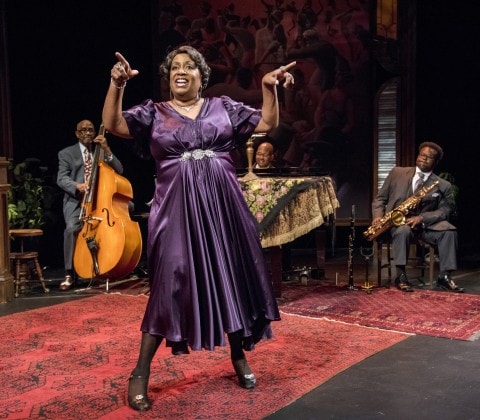 The Mosaic Theater Company ignites its third season with a sure hit, a proven crowd-pleaser about the Empress of Blues.
The Mosaic Theater Company ignites its third season with a sure hit, a proven crowd-pleaser about the Empress of Blues.
“The Devil’s Music: The Life & Blues of Bessie Smith” retells the story of the American musical legend, and is as sure to delight audiences here as it did when it premiered Off-Broadway in 2001 with the same creative team.
Miche Braden makes her presence known immediately as the title character, with the kind of big voice that made Smith a big star 90 years ago. Storming into a beautifully attired den, having just been turned away from an all-white performance in Memphis (or rather, refusing to go into the Coloreds Only door), she is already in song and commanding attention. It’s 1937, she’s 43 and she doesn’t know it’s her last night on Earth.
Braden, who also arranged the dozen or so songs in the piece, doesn’t quite have the exact voice of Smith (whose songs, sadly, are scarcely heard today), but makes up in grit and power what she may lack in rounded notes and vulnerability.
Braden brings an oversized personality and has more than enough to keep attention as she recalls Smith’s remarkable ups and downs. And the key to Smith’s success is also the key to her’s: The songs reflect her own hard times and striving and makes it especially easy to turn to just the right song amid the autobiography.
The Bessie Smith story, which never completely went away, had another resurgence when Queen Latifah took up the role in a highly regarded HBO film two years ago. And so her sometimes bawdy stories of rising up from a trying childhood to a traveling troupe led by another giant of the blues, Ma Rainey, to eclipse her in popularity, are somewhat familiar, as is the sadder tale of being taken advantage by conniving men throughout her life, which was also the plot of her one 15-minute movie, the 1929 “St. Louis Blues.”
Her lifelong relationship to the boogie man, who rise up hooded in KKK cloaks, makes “The Devil’s Music” as contemporary as clashes in Charlottesville. In her case, she chased them away.
(And it would be even more topical if she chose to include “Backwater Blues,” about poor people made homeless by a flood).
Her rough and tumble relationship with her husband Jack Gee is recalled, as is her sad custody battle for a son she lost because of charges of bisexuality.
The largely one-woman performance is aided considerably by the able jazz trio backing her that includes Gerald Gibbs on piano and Anthony E. Nelson Jr. on saxophone and clarinet, who also rises to do a randy dance with the star.
The chief foil in the band is bassist Jim Hankins, who in real life is uncle to Braden. Like her, he hails from Detroit and has some solid Motown credentials, and knows his chops on his stand-up instrument. But he is also the apparent narrator who frames the work, though his words unfortunately come largely pre-recorded.
It’s not explained on stage exactly where Smith is telling her tale; it’s not exactly a hotel lobby (she famously traveled in her own lavish railroad car to avoid the colored-only rules), and it’s not exactly a club.
Actually, it’s a “buffet flat” – a place where black entertainers could come after hours without hassles and turn in a performance that’s much more laid back and allowed for the storytelling. The audience is expected to be that audience, answering her, clapping and eventually singing along.
That’s because the script by playwright Angelo Parra makes way for some of the best known songs of the era, from “I Ain’t Got Nobody” and “St. Louis Blues” to “Taint Nobody’s Business If I Do.”
Original director Joe Brancato continues his sure hand here and the set by James Prather is a knockout, incorporating a painting by Archibald J. Motley, “Nightlife,” to help set the scene. Part of Todd O. Wren’s lighting design involves Tiffany lamps.
Mosaic’s biggest box office hit to date was last year’s Louis Armstrong play “Satchmo at the Waldorf” and that didn’t even include music. This one, a fine blend of drama and gut-punch music, ought to surpass it.
“The Devil’s Music: The Life and Blues of Bessie Smith” continues through Sept. 24 at the Atlas Performing Arts Center.